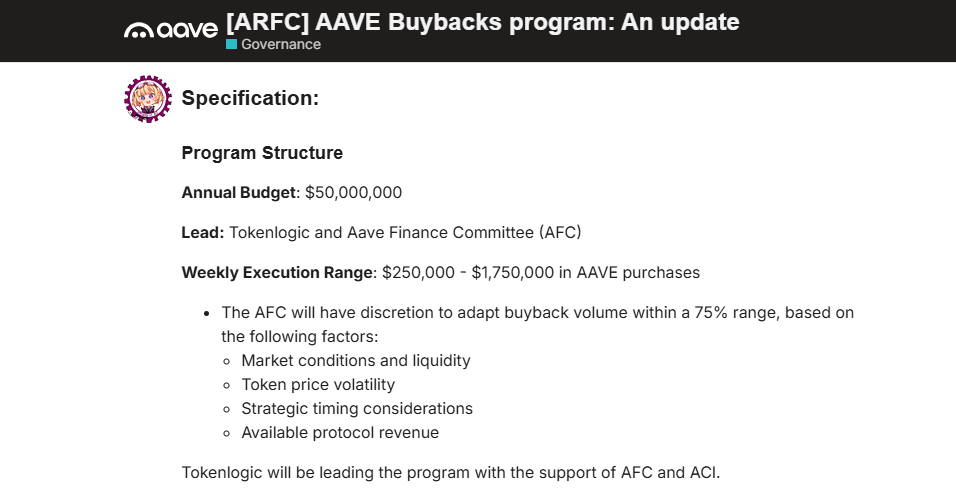TL;DR
- Aave DAO has submitted a proposal to set aside up to $50 million annually for token buybacks, aiming to make repurchases a permanent part of its treasury management.
- The plan, introduced by the Aave Chan Initiative (ACI), would see weekly buybacks of between $250,000 to $1.75 million in AAVE tokens, depending on market conditions.
- This moves beyond past one-off repurchase actions; the proposal transforms the DAO into an active capital allocator rather than a passive protocol.
- The buyback strategy comes ahead of the upcoming Aave v4 upgrade, which promises a modular "hub & spoke" architecture to improve scalability and risk configurations.
The Aave DAO's latest governance submission aims to elevate token buybacks from ad-hoc interventions to a recurring, institutionalized mechanism. Under the draft proposal, Treasury would allocate up to $50 million annually - drawn from protocol revenues - to systematically repurchase AAVE. Execution would be managed by the Aave Finance Committee (AFC) and TokenLogic, subject to market liquidity, volatility, and treasury health. Weekly purchases could range from $250,000 to $1.75 million.
This represents a shift in mindset: from responding to undervaluation spurts to establishing a rule-based capital strategy. In April, for example, Aave's community approved a $4 million buyback , which boosted AAVE by around 13%. The current initiative builds on that precedent but seeks permanence rather than one-time effect.
Why Now? Timing, Tokenomics and Upgrade Ahead
Several converging factors make this moment strategic for Aave. Firstly, the proposal appears just as the Aave ecosystem prepares for its v4 upgrade - earmarked for Q4 2025 - which introduces a modular "hub and spoke" architecture. This upgrade is meant to improve efficiency, asset risk management and liquidity pooling across lending markets. Embedding a reliable capital-return mechanism now could strengthen the governance narrative as the protocol enters this next technical phase.
Secondly, in terms of tokenomics, the move speaks to an evolving expectation: DeFi protocols are no longer judged solely by yield or TVL (total value locked) but also by how they manage capital, governance and long-term value accrual for their token holders. By committing to a recurring buyback programme, Aave is signalling maturity - aligning with corporate-style financial tactics while remaining decentralized.
Finally, the market backdrop is supportive. Token markets remain sensitive to buyback signals, and for protocols with excess cash or fee-generating platforms, capital allocation is becoming a key differentiator. AAVE's prior positive reaction to buyback news suggests the community understands the message.
How the Program Would Work

If the proposal is approved, the first step is an "ARFC" (Aave Request for Comment) phase for community feedback, followed by a Snapshot vote and on-chain governance confirmation. Once live, the buyback engine would operate continuously, subject to predefined guardrails. Each week the AFC and TokenLogic would decide on the volume within the $250k-$1.75 m range depending on market and treasury conditions.
The repurchased AAVE would presumably be burnt or locked (depending on governance decision), reducing circulating supply and providing support to token value. The idea is not just to buy, but to create sustainable value for holders by shrinking supply while aligning with ongoing ecosystem growth.
Governance, Risks and Community Response
While the plan is bold, some governance questions and risks are on the table. There must be transparency in how buyback volumes are decided, ensuring they don't compromise treasury reserves or ecosystem development. Some community members may argue that capital should go to protocol growth or grants rather than buyback.
Secondly, market conditions could hamper execution: if liquidity dries up or volatility spikes, buying large amounts weekly could move the market against itself. The proposal's flexible weekly volume is meant to mitigate this, but it remains a balancing act.
Community sentiment appears cautiously positive. Aave stakeholders are used to proactive governance, and the shift from reactive to proactive buybacks is seen as a sign of institutional maturity for a DeFi protocol.
Implications Beyond Aave
This initiative may have broader implications across the crypto ecosystem. If successful, it could set a precedent for other protocols to adopt structured, recurring capital allocation strategies rather than ad-hoc buybacks or yield-only models. Such models appeal to more traditional finance investors who appreciate predictable governance, capped program volumes and transparency.
For holders of AAVE, the proposal could enhance token value stability and provide added incentive to participate in governance. For the ecosystem, it underscores a shift: DeFi protocols are now thinking in terms of balance sheets, capital discipline and shareholder (token-holder) value - language traditionally reserved for corporate finance.
Final Thought
The Aave DAO's $50 million annual buyback proposal marks a significant moment in the evolution of DeFi governance and tokenomics. It reflects a shift from opportunistic token support to systematic capital management - one that bridges decentralized protocols with the financial sophistication of traditional firms. If executed carefully and transparently, Aave could demonstrate that protocols don't just need to innovate - they need to behave like responsible stewards of value.
READ MORE : What is COTI V2: Revolutionizing Blockchain Privacy with Garbled Circuits











